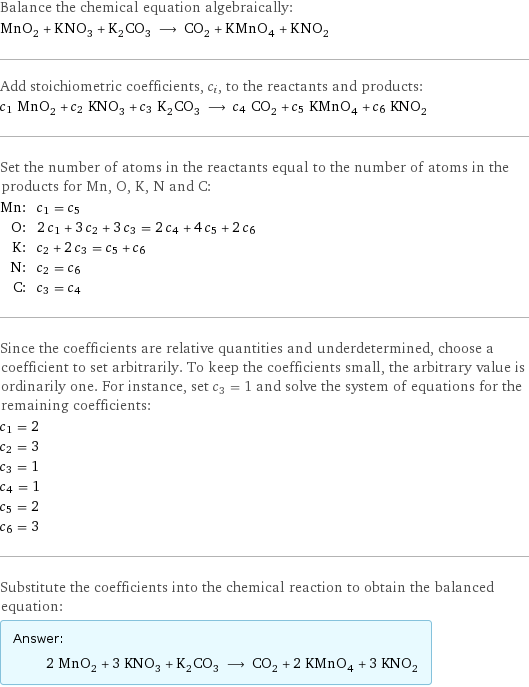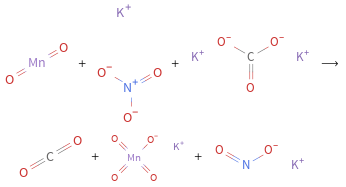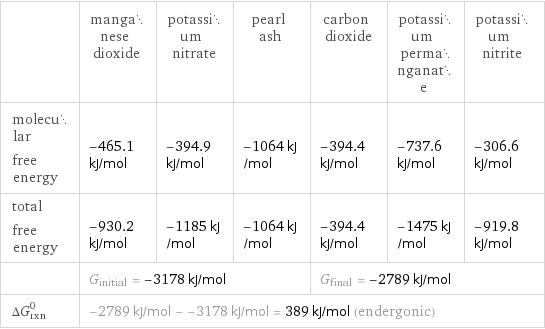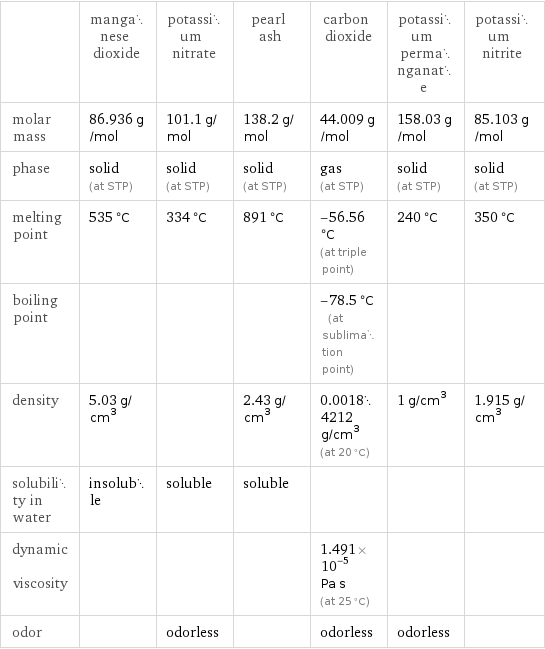Input interpretation

MnO_2 manganese dioxide + KNO_3 potassium nitrate + K_2CO_3 pearl ash ⟶ CO_2 carbon dioxide + KMnO_4 potassium permanganate + KNO_2 potassium nitrite
Balanced equation

Balance the chemical equation algebraically: MnO_2 + KNO_3 + K_2CO_3 ⟶ CO_2 + KMnO_4 + KNO_2 Add stoichiometric coefficients, c_i, to the reactants and products: c_1 MnO_2 + c_2 KNO_3 + c_3 K_2CO_3 ⟶ c_4 CO_2 + c_5 KMnO_4 + c_6 KNO_2 Set the number of atoms in the reactants equal to the number of atoms in the products for Mn, O, K, N and C: Mn: | c_1 = c_5 O: | 2 c_1 + 3 c_2 + 3 c_3 = 2 c_4 + 4 c_5 + 2 c_6 K: | c_2 + 2 c_3 = c_5 + c_6 N: | c_2 = c_6 C: | c_3 = c_4 Since the coefficients are relative quantities and underdetermined, choose a coefficient to set arbitrarily. To keep the coefficients small, the arbitrary value is ordinarily one. For instance, set c_3 = 1 and solve the system of equations for the remaining coefficients: c_1 = 2 c_2 = 3 c_3 = 1 c_4 = 1 c_5 = 2 c_6 = 3 Substitute the coefficients into the chemical reaction to obtain the balanced equation: Answer: | | 2 MnO_2 + 3 KNO_3 + K_2CO_3 ⟶ CO_2 + 2 KMnO_4 + 3 KNO_2
Structures

+ + ⟶ + +
Names

manganese dioxide + potassium nitrate + pearl ash ⟶ carbon dioxide + potassium permanganate + potassium nitrite
Reaction thermodynamics
Gibbs free energy

| manganese dioxide | potassium nitrate | pearl ash | carbon dioxide | potassium permanganate | potassium nitrite molecular free energy | -465.1 kJ/mol | -394.9 kJ/mol | -1064 kJ/mol | -394.4 kJ/mol | -737.6 kJ/mol | -306.6 kJ/mol total free energy | -930.2 kJ/mol | -1185 kJ/mol | -1064 kJ/mol | -394.4 kJ/mol | -1475 kJ/mol | -919.8 kJ/mol | G_initial = -3178 kJ/mol | | | G_final = -2789 kJ/mol | | ΔG_rxn^0 | -2789 kJ/mol - -3178 kJ/mol = 389 kJ/mol (endergonic) | | | | |
Equilibrium constant
![Construct the equilibrium constant, K, expression for: MnO_2 + KNO_3 + K_2CO_3 ⟶ CO_2 + KMnO_4 + KNO_2 Plan: • Balance the chemical equation. • Determine the stoichiometric numbers. • Assemble the activity expression for each chemical species. • Use the activity expressions to build the equilibrium constant expression. Write the balanced chemical equation: 2 MnO_2 + 3 KNO_3 + K_2CO_3 ⟶ CO_2 + 2 KMnO_4 + 3 KNO_2 Assign stoichiometric numbers, ν_i, using the stoichiometric coefficients, c_i, from the balanced chemical equation in the following manner: ν_i = -c_i for reactants and ν_i = c_i for products: chemical species | c_i | ν_i MnO_2 | 2 | -2 KNO_3 | 3 | -3 K_2CO_3 | 1 | -1 CO_2 | 1 | 1 KMnO_4 | 2 | 2 KNO_2 | 3 | 3 Assemble the activity expressions accounting for the state of matter and ν_i: chemical species | c_i | ν_i | activity expression MnO_2 | 2 | -2 | ([MnO2])^(-2) KNO_3 | 3 | -3 | ([KNO3])^(-3) K_2CO_3 | 1 | -1 | ([K2CO3])^(-1) CO_2 | 1 | 1 | [CO2] KMnO_4 | 2 | 2 | ([KMnO4])^2 KNO_2 | 3 | 3 | ([KNO2])^3 The equilibrium constant symbol in the concentration basis is: K_c Mulitply the activity expressions to arrive at the K_c expression: Answer: | | K_c = ([MnO2])^(-2) ([KNO3])^(-3) ([K2CO3])^(-1) [CO2] ([KMnO4])^2 ([KNO2])^3 = ([CO2] ([KMnO4])^2 ([KNO2])^3)/(([MnO2])^2 ([KNO3])^3 [K2CO3])](../image_source/fe224dbba5f25510b6c64f0efd518c06.png)
Construct the equilibrium constant, K, expression for: MnO_2 + KNO_3 + K_2CO_3 ⟶ CO_2 + KMnO_4 + KNO_2 Plan: • Balance the chemical equation. • Determine the stoichiometric numbers. • Assemble the activity expression for each chemical species. • Use the activity expressions to build the equilibrium constant expression. Write the balanced chemical equation: 2 MnO_2 + 3 KNO_3 + K_2CO_3 ⟶ CO_2 + 2 KMnO_4 + 3 KNO_2 Assign stoichiometric numbers, ν_i, using the stoichiometric coefficients, c_i, from the balanced chemical equation in the following manner: ν_i = -c_i for reactants and ν_i = c_i for products: chemical species | c_i | ν_i MnO_2 | 2 | -2 KNO_3 | 3 | -3 K_2CO_3 | 1 | -1 CO_2 | 1 | 1 KMnO_4 | 2 | 2 KNO_2 | 3 | 3 Assemble the activity expressions accounting for the state of matter and ν_i: chemical species | c_i | ν_i | activity expression MnO_2 | 2 | -2 | ([MnO2])^(-2) KNO_3 | 3 | -3 | ([KNO3])^(-3) K_2CO_3 | 1 | -1 | ([K2CO3])^(-1) CO_2 | 1 | 1 | [CO2] KMnO_4 | 2 | 2 | ([KMnO4])^2 KNO_2 | 3 | 3 | ([KNO2])^3 The equilibrium constant symbol in the concentration basis is: K_c Mulitply the activity expressions to arrive at the K_c expression: Answer: | | K_c = ([MnO2])^(-2) ([KNO3])^(-3) ([K2CO3])^(-1) [CO2] ([KMnO4])^2 ([KNO2])^3 = ([CO2] ([KMnO4])^2 ([KNO2])^3)/(([MnO2])^2 ([KNO3])^3 [K2CO3])
Rate of reaction
![Construct the rate of reaction expression for: MnO_2 + KNO_3 + K_2CO_3 ⟶ CO_2 + KMnO_4 + KNO_2 Plan: • Balance the chemical equation. • Determine the stoichiometric numbers. • Assemble the rate term for each chemical species. • Write the rate of reaction expression. Write the balanced chemical equation: 2 MnO_2 + 3 KNO_3 + K_2CO_3 ⟶ CO_2 + 2 KMnO_4 + 3 KNO_2 Assign stoichiometric numbers, ν_i, using the stoichiometric coefficients, c_i, from the balanced chemical equation in the following manner: ν_i = -c_i for reactants and ν_i = c_i for products: chemical species | c_i | ν_i MnO_2 | 2 | -2 KNO_3 | 3 | -3 K_2CO_3 | 1 | -1 CO_2 | 1 | 1 KMnO_4 | 2 | 2 KNO_2 | 3 | 3 The rate term for each chemical species, B_i, is 1/ν_i(Δ[B_i])/(Δt) where [B_i] is the amount concentration and t is time: chemical species | c_i | ν_i | rate term MnO_2 | 2 | -2 | -1/2 (Δ[MnO2])/(Δt) KNO_3 | 3 | -3 | -1/3 (Δ[KNO3])/(Δt) K_2CO_3 | 1 | -1 | -(Δ[K2CO3])/(Δt) CO_2 | 1 | 1 | (Δ[CO2])/(Δt) KMnO_4 | 2 | 2 | 1/2 (Δ[KMnO4])/(Δt) KNO_2 | 3 | 3 | 1/3 (Δ[KNO2])/(Δt) (for infinitesimal rate of change, replace Δ with d) Set the rate terms equal to each other to arrive at the rate expression: Answer: | | rate = -1/2 (Δ[MnO2])/(Δt) = -1/3 (Δ[KNO3])/(Δt) = -(Δ[K2CO3])/(Δt) = (Δ[CO2])/(Δt) = 1/2 (Δ[KMnO4])/(Δt) = 1/3 (Δ[KNO2])/(Δt) (assuming constant volume and no accumulation of intermediates or side products)](../image_source/f5f96ca830fe3def985188ba58b0f3ac.png)
Construct the rate of reaction expression for: MnO_2 + KNO_3 + K_2CO_3 ⟶ CO_2 + KMnO_4 + KNO_2 Plan: • Balance the chemical equation. • Determine the stoichiometric numbers. • Assemble the rate term for each chemical species. • Write the rate of reaction expression. Write the balanced chemical equation: 2 MnO_2 + 3 KNO_3 + K_2CO_3 ⟶ CO_2 + 2 KMnO_4 + 3 KNO_2 Assign stoichiometric numbers, ν_i, using the stoichiometric coefficients, c_i, from the balanced chemical equation in the following manner: ν_i = -c_i for reactants and ν_i = c_i for products: chemical species | c_i | ν_i MnO_2 | 2 | -2 KNO_3 | 3 | -3 K_2CO_3 | 1 | -1 CO_2 | 1 | 1 KMnO_4 | 2 | 2 KNO_2 | 3 | 3 The rate term for each chemical species, B_i, is 1/ν_i(Δ[B_i])/(Δt) where [B_i] is the amount concentration and t is time: chemical species | c_i | ν_i | rate term MnO_2 | 2 | -2 | -1/2 (Δ[MnO2])/(Δt) KNO_3 | 3 | -3 | -1/3 (Δ[KNO3])/(Δt) K_2CO_3 | 1 | -1 | -(Δ[K2CO3])/(Δt) CO_2 | 1 | 1 | (Δ[CO2])/(Δt) KMnO_4 | 2 | 2 | 1/2 (Δ[KMnO4])/(Δt) KNO_2 | 3 | 3 | 1/3 (Δ[KNO2])/(Δt) (for infinitesimal rate of change, replace Δ with d) Set the rate terms equal to each other to arrive at the rate expression: Answer: | | rate = -1/2 (Δ[MnO2])/(Δt) = -1/3 (Δ[KNO3])/(Δt) = -(Δ[K2CO3])/(Δt) = (Δ[CO2])/(Δt) = 1/2 (Δ[KMnO4])/(Δt) = 1/3 (Δ[KNO2])/(Δt) (assuming constant volume and no accumulation of intermediates or side products)
Chemical names and formulas

| manganese dioxide | potassium nitrate | pearl ash | carbon dioxide | potassium permanganate | potassium nitrite formula | MnO_2 | KNO_3 | K_2CO_3 | CO_2 | KMnO_4 | KNO_2 Hill formula | MnO_2 | KNO_3 | CK_2O_3 | CO_2 | KMnO_4 | KNO_2 name | manganese dioxide | potassium nitrate | pearl ash | carbon dioxide | potassium permanganate | potassium nitrite IUPAC name | dioxomanganese | potassium nitrate | dipotassium carbonate | carbon dioxide | potassium permanganate | potassium nitrite
Substance properties

| manganese dioxide | potassium nitrate | pearl ash | carbon dioxide | potassium permanganate | potassium nitrite molar mass | 86.936 g/mol | 101.1 g/mol | 138.2 g/mol | 44.009 g/mol | 158.03 g/mol | 85.103 g/mol phase | solid (at STP) | solid (at STP) | solid (at STP) | gas (at STP) | solid (at STP) | solid (at STP) melting point | 535 °C | 334 °C | 891 °C | -56.56 °C (at triple point) | 240 °C | 350 °C boiling point | | | | -78.5 °C (at sublimation point) | | density | 5.03 g/cm^3 | | 2.43 g/cm^3 | 0.00184212 g/cm^3 (at 20 °C) | 1 g/cm^3 | 1.915 g/cm^3 solubility in water | insoluble | soluble | soluble | | | dynamic viscosity | | | | 1.491×10^-5 Pa s (at 25 °C) | | odor | | odorless | | odorless | odorless |
Units
